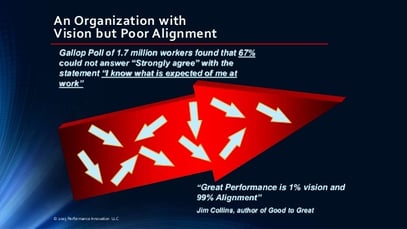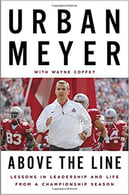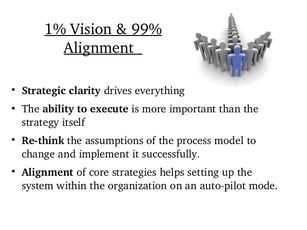 In Good to Great Jim Collins emphasizes the importance of getting your team aligned to achieve great performance.
In Good to Great Jim Collins emphasizes the importance of getting your team aligned to achieve great performance.
Most companies invest a good deal of time in creating a vision, however, too often this vision is scattered across memos, documents, and emails. Seldom is there a place holder anywhere to store or share the strategy of the company.
It’s one reason our One Page Strategic Plan is so valuable. Collins notes, “Great performance is about 1% vision and 99% alignment.”
One Inc Magazine survey discovered, while 92% of CEO’s believe their leadership teams agree with and can communicate their strategy. When surveying their leadership teams, it was discovered only 2% could.
If you have a hard time believing these numbers, consider Urban Meyer’s comment on alignment from Above the Line, “You’d be surprised how rare it is for teams to be in alignment. In twenty-nine years of coaching, I’ve been a part of five teams—coaches, players, and support staff—that have been fully aligned. Twenty-four of them were not, and in each instance, the team underperformed because of it.”
Meyer's Above the Line affirms Gazelles Scaling Up principles. One of the greatest coaches in college football has learned the same best practices Gazelles customers follow.
URBAN MEYER ON ALIGNMENT
Here are some of Urban Meyer's thoughts on the importance of alignment, “In order to achieve elite performance, alignment is essential. When a team is aligned, everyone understands and is fully committed to the team’s purpose, culture, and strategy.”
What’s alignment look like, “In an aligned organization, every employee—from the executive suite to the loading dock—understands not only the strategies and goals of the business, but also how their individual contribution matters”
Why alignment is critical, “An aligned organization gets things done faster and with better results and is more agile and responsive to the competitive environment.”
To achieve great performance alignment trumps strategy because, “Alignment is a key ingredient to elite performance because without it the best strategy in the world cannot be executed.”
LEADERS CREATE DIRECTION
Meyer offers a parallel to physic to explain why alignment is so critical, “In physics, the principle of inertia dictates that objects in motion tend to stay in motion unless acted upon by sufficient energy. This principle holds true for objects that are not in motion as well. Objects at rest tend to stay at rest. Inertia also applies to teams. It requires sufficient energy to get a group of players, and a group of units, to align around a common culture in pursuit of a common goal and to execute a common strategy.”
 “That energy is called leadership.”
“That energy is called leadership.”
Who is responsible for creating and directing this energy? “Each player and each unit is moving in a particular direction. The task of a leader is to provide a center of gravity that exerts a pull—attraction and energy—that aligns the trajectory of every player and every unit. In other words, it’s leadership that gets every player and every unit on the team going in the same direction.”
If your organization isn’t moving in the same direction, your leaders are failing to direct and provide the energy to achieve great performance, “It’s physics. It’s a nonnegotiable law of nature.”
FIND THE BALANCE
You may already have seen how some leaders understand and communicate well this energy. Meyer shares the importance of balance in leadership.
.jpg?width=280&name=Urban%20Meyer%20(Yet%20to%20be%20in%20a%20game%20where%20Luck%20was%20Involved).jpg) “For us to be Nine Strong (Meyer’s theme for 2014) and operate at maximum capacity requires the right amount of leadership energy. It’s a balance. On one end of the spectrum, if a leader exerts too much energy, too much gravitational pull, he impairs developmental momentum and slows down his players. These are the command-and-control leaders who try to micromanage everything. They are heavy-handed and harsh in the way they deal with players. Often, they create a culture of fear. As a result, they disconnect, discourage, and demotivate players.
“For us to be Nine Strong (Meyer’s theme for 2014) and operate at maximum capacity requires the right amount of leadership energy. It’s a balance. On one end of the spectrum, if a leader exerts too much energy, too much gravitational pull, he impairs developmental momentum and slows down his players. These are the command-and-control leaders who try to micromanage everything. They are heavy-handed and harsh in the way they deal with players. Often, they create a culture of fear. As a result, they disconnect, discourage, and demotivate players.
Does this sound familiar to your leadership team. Meyer’s goes on.
“On the other end of the spectrum, when a leader exerts too little energy, too little gravitational pull, the players spin off in all kinds of directions. These are the laissez-faire leaders. They don’t demand enough. Their standards are not clear, and they don’t hold their players accountable. They are lenient and soft. They want to be buddies or friends with players. They allow an undisciplined culture.”
The best leaders know which levers to pull to achieve great performance, “On either end of the spectrum—too controlling or too permissive—you lose alignment, performance suffers, and we are no longer Nine Units Strong.”
TRAIN TO LEAD
Why is Ohio State consistently a winner? They don’t just train their players, they train them to lead. “As I’ve shared already in this book, we invest heavily in training our unit leaders and our players on how to lead. We don’t leave it to chance. In addition to the training sessions we hold, we are constantly talking about leadership. And please understand, these are purposeful conversations that focus on the impact of leadership on our culture and the performance of our team.”
ACHIEVING ALIGNMENT
How do you achieve alignment? What can Urban Meyer teach us?
Urban Meyer’s ideas on how you get alignment:
- Hire the right people and recruit the right players. (see Your Hiring Batting Average – The NFL Draft Standard – Topgrade your team)
- Communicate your purpose and your culture with exceptional clarity and relentless consistency. (Develop Annual, Quarterly plans and themes, Determine Your One Thing.)
- Make it clear to your leaders that it is their responsibility to build and maintain alignment, then equip them with essential skills. Hold everyone accountable. (see our Accountability Tool and Meeting Rhythms.)
- If someone is out of alignment, deal with it quickly and decisively.
Bill Belichick has often told Meyer, “Always bring in people who can enhance what you do without changing the basics of it.”
Would you like your team to achieve greater performance? Do you need to get your team aligned? Contact dwick@positioningsystems.com to get Strategic Discipline and our Gazelles tools to measurable grow your business.
SUMMARY
The Necessity of Alignment Playbook
- To achieve elite performance, alignment is essential.
- An aligned organization gets things done faster and with better results, and is more agile and responsive to the competitive environment.
- Achieving alignment requires effective leadership. Avoid the extremes of command and control and leniency. Find the balance.
- Bring in people who believe in what you are doing and will help you make it better.
- Hold everyone accountable. If someone is out of alignment, deal with it quickly and decisively.
NEXT BLOG – 10-80-10 RULE
How do you take an aligned team and achieve greater results? Meyer shares his 10-80-10 rule on people. Discover the critical nature of time, who to focus on and how, next blog.






.jpeg?width=150&height=135&name=Hand%20with%20marker%20writing%20the%20question%20Whats%20Next_%20(1).jpeg)

